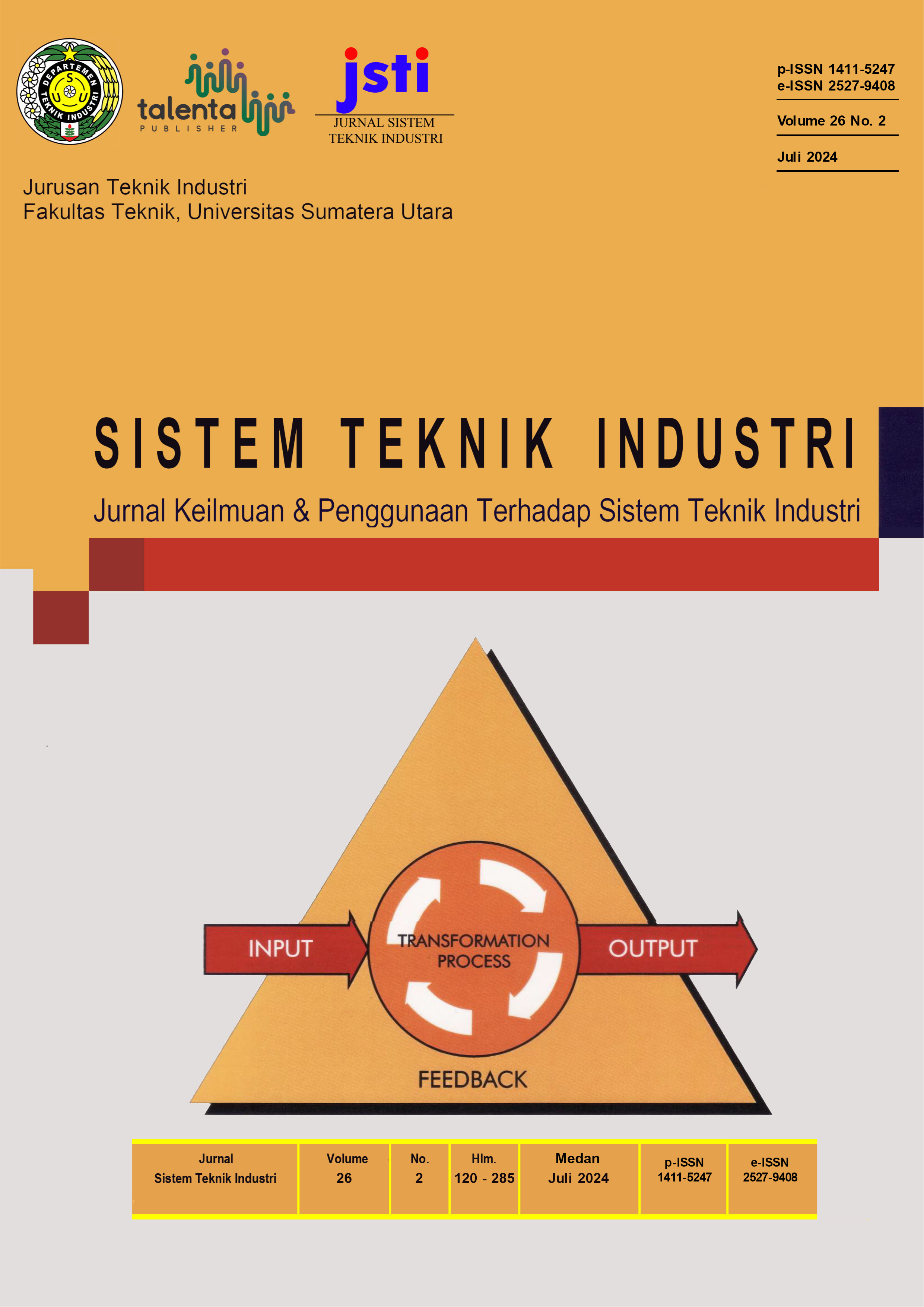Evaluation of Container Yard Locations Using Discrete Simulation Method
DOI:
https://doi.org/10.32734/jsti.v26i2.16203Keywords:
Container Yard, Discreate Event Simulation, Truck Round Time, Waiting TimeAbstract
The loading and unloading process are activity of unloading goods from ships with cranes and then being brought and arranged in temporary warehouses. PT Prima Termina Petikemas is a subsidiary of Pelindo which is engaged in shipping container loading and unloading services. For customer satisfaction, one of the indicators of the company is the truck round time (TRT) which is 33 minutes. Currently, the external truck round time (TRT) for delivery is 43.62 minutes with waiting time by 16.32 minutes and truck round time (TRT) receiving is 37.72 minutes with waiting time by 9.75 minutes. The discrete event simulation method aims to evaluate the determination of effective alternative container yard locations to anticipate truck round time (TRT). For all improvement scenarios carried out, the selected scenario for delivery using 4 blocks and 6 units of Automated Rubber Gantry Tyred (1 unit reach stacker) and the percentage of each block load is 20%. This can reduce the truck round time (TRT) 27.37 minutes with the waiting time is to 8.93 minutes. For receiving activity using 5 blocks and 6 units of Automated Rubber Gantry Tyred (ARTG) and the percentage of each block load is 20%. The waiting time become 9.92 minutes and this reduces the truck round time (TRT) by 33.67 minutes.
Downloads
References
C. R. Wakarmamu, M. Sofitra, and noveicalistus H. Djanggu, “Rekomendasi Skenario Bongkar Muat Peti Kemas Dengan Menggunakan Pendekatan Simulasi Pada Pt. X,†J. TIN Univ. Tanjungpura, vol. 4, no. 2, pp. 139–143, 2020, [Online]. Available: https://jurnal.untan.ac.id/index.php/jtinUNTAN/article/view/42640
C. Tan, J. He, and Y. Wang, “Advanced Engineering Informatics Storage yard management based on fl exible yard template in container terminal,†Adv. Eng. Informatics, vol. 34, no. October, pp. 101–113, 2017, doi: 10.1016/j.aei.2017.10.003.
A. Azab, A. Karam, A. Eltawil, A. Azab, and A. Karam, “A simulation-based optimization approach for external trucks appointment scheduling in container terminals scheduling in container terminals,†Int. J. Model. Simul., vol. 00, no. 00, pp. 1–18, 2019, doi: 10.1080/02286203.2019.1615261.
G. Giambene, Queuing theory and telecommunications: Networks and applications. 2014. doi: 10.1007/978-1-4614-4084-0.
A. Dudin, V. Klimenok, and V. Vishnevsky, TheeTheory offQueuing Systems withhCorrelated Flows. 2020.
W. Basuki, M. Oktavia, and A. Elfistoni, “Perhitungan Kebutuhan Unit Dump Truck Berdasarkan Match Factor Dan Teori Antrian Pada Penambangan Batubara Di PT. Kamalindo Sompurna Kecamatan Pelawan Kabupaten Sarolangun Provinsi Jambi,†Mine Mag., vol. 1, no. 2, pp. 1–7, 2020.
J. He, C. Tan, and Y. Zhang, “Yard crane scheduling problem in a container terminal considering risk caused by uncertainty,†Adv. Eng. Informatics, vol. 39, no. November 2018, pp. 14–24, 2019, doi: 10.1016/j.aei.2018.11.004.
H. Yu, J. Ning, Y. Wang, J. He, and C. Tan, “Flexible yard management in container terminals for uncertain retrieving sequence,†Ocean Coast. Manag., vol. 212, no. March, p. 105794, 2021, doi: 10.1016/j.ocecoaman.2021.105794.
H. Yu, M. Zhang, J. He, and C. Tan, “Choice of loading clusters in container terminals,†Adv. Eng. Informatics, vol. 46, no. September, p. 101190, 2020, doi: 10.1016/j.aei.2020.101190.
M. Stojaković and E. Twrdy, “Determining the optimal number of yard trucks in smaller container terminals,†Eur. Transp. Res. Rev., vol. 13, no. 1, 2021, doi: 10.1186/s12544-021-00482-6.
M. I. Tama, N. Siswanto, Suparno, and B. D. Aqsha, “Discrete Event Simulation Modelling for Classifying the Container Yard Availability Considering Dock Unloading Activity,†IOP Conf. Ser. Mater. Sci. Eng., vol. 847, no. 1, 2020, doi: 10.1088/1757-899X/847/1/012082.
R. Dekker, P. Voogd, and E. Van Asperen, “Advanced methods for container stacking,†Int. Work. Harbour, Marit. Multimodal Logist. Model. Simulation, HMS 2005, Held Int. Mediterr. Model. Multiconference, I3M 2005, vol. 1999, pp. 17–18, 2005.
L. Rohmana, “Automatic Stacking Cranes Dengan Mempertimbangkan Turnaround Time,†pp. 1–5, 2016.
J. Luo and Y. Wu, “Scheduling of container-handling equipment during the loading process at an automated container terminal,†Comput. Ind. Eng., vol. 149, no. September, p. 106848, 2020, doi: 10.1016/j.cie.2020.106848.
X. Hu, J. Guo, and Y. Zhang, “Optimal strategies for the yard truck scheduling in container terminal with the consideration of container clusters,†Comput. Ind. Eng., vol. 137, no. September, p. 106083, 2019, doi: 10.1016/j.cie.2019.106083.
B. Khoshnevis, “Discrete-Systems-Simulation-Khoshnevis.pdf.†1994.
J. Karnon, J. Stahl, A. Brennan, J. J. Caro, J. Mar, and J. Möller, “Modeling using discrete event simulation: A report of the ISPOR-SMDM modeling good research practices task force-4,†Med. Decis. Mak., vol. 32, no. 5, pp. 701–711, 2012, doi: 10.1177/0272989X12455462.
and L. C. Dewa, M, “Managing Bottlenecks In Manual Automobile Assembly Systems Using Discrete Event Simulation,†Manag. Bottlenecks Man. Automob. Assem. Syst. Using Discret. Event Simul., vol. 5, no. 1, pp. 137–138, 2013, doi: 10.21608/egjec.2013.94997.
K. P. Mentor, Simulation Modeling Arena. 2016.
P. Arena-um, “USER’S GUIDE Arena ®,†no. November, 2007, [Online]. Available: http://www.rockwellautomation.com/support/
A. Maria, “Introduction to modeling and simulation,†Winter Simul. Conf. Proc., pp. 7–13, 1997, doi: 10.1145/268437.268440.
Downloads
Published
How to Cite
Issue
Section
License
Copyright (c) 2024 TALENTA Publisher Universitas Sumatera Utara

This work is licensed under a Creative Commons Attribution-ShareAlike 4.0 International License.
The Authors submitting a manuscript do so on the understanding that if accepted for publication, the copyright of the article shall be assigned to TALENTA Publisher Universitas Sumatera Utara as the publisher of the journal.
Copyright encompasses the rights to reproduce and deliver the article in all forms and media. The reproduction of any part of this journal, its storage in databases, and its transmission by any form or medium will be allowed.



















